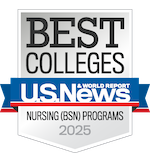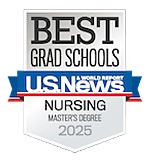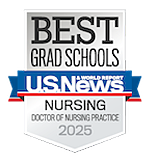Olivia M. Halabicky, MSc, PhD, RN

University of Michigan School of Nursing
400 North Ingalls Building
Ann Arbor, MI 48109-5482
In the news
Feb 8, 2024: National Geographic "This is what you need to know about lead and your health"
Interests
- Environmental exposures
- Child health and neurodevelopment
- Global health equity
- Adversity and stress
- Longitudinal cohort studies
Dr. Halabicky is a children’s environmental health nurse scientist who studies early life environmental and social determinants of health and human development. Her research focuses on how inequitable exposures in the global sphere (e.g., toxicants, adversity, nutrition) at sensitive periods shape health trajectories and influence health disparities, as well as physiological mechanisms that may mediate these effects. She employs methods from a variety of disciplines including nursing, environmental and social epidemiology, and developmental sciences.
Current Research Grants and Programs
- Center Scientist Award. Michigan Lifestage Environmental Exposures and Disease (M-LEEaD) Center. Role: PI.
- National Institute of Nursing Research (L30 NR020943). The role of early life lead and psychosocial co-exposures on adolescent physiological stress. Role: PI.
Teaching
Dr. Halabicky has formal teaching and mentorship experience in both the Schools of Nursing and Public Health. She has devliered a number of guest lectures in undergraduate and graduate courses on topics related to environmental toxicant and adversity exposure and their impacts on child health and neurodevelopment and instructed a graduate course in the School of Public Health focused on community programming and evaluation. She works to ensure that students are well-prepared to thrive in interdisciplinary environments. In her roles as an instructor or guest lecturer, she leverages her clinical experience as a pediatric nurse and her scholarly work in public health to cultivate skills within the classroom environment.
Affiliations / Service
- Member, Center for Global Health Equity, University of Michigan, 2024 - present
- Member, Society for Pediatric and Perinatal Epidemiologic Research, 2022 - 2024
- Member, Alliance of Nurses for Healthy Environments, 2020 - present
- Member, International Society for Environmental Epidemiology, 2020 - present
- Member, Society for Research in Child Development, 2019 - present
- Member, Midwest Nursing Research Society, 2015 - present; (Chair of Emerging Scholars Network, 2023-2025; Chair of Population Health RIIG 2024-2025; Member DEI Taskforce 2024)
- Member, Sigma Theta Tau International, 2014 - present; (Theta Chi Chapter 2014-2022; Rho Chapter 2022 - present)
Notable Awards / Honors
- Scholar, Michigan Program for Advancing Cultural Transformation (M-PACT), University of Michigan, 2024
- Center Scientist, Michigan Lifestage Environmental Exposures and Disease (M-LEEaD) Center, 2024-2025
- Award, Rising Star, Rho Chapter Sigma Theta Tau International, 2023
- Fellow, Early Career Interdisciplinary Scholars, Society for Research in Child Development, 2023
- Future of Nursing Scholar, Robert Wood Johnson Foundation, 2018-2021
- Award, Young Alumni, Saginaw Valley State University, 2018
Education
- PhD, University of Pennsylvania, Philadelphia, PA 2021
- MSc, Trinity College Dublin, Dublin Ireland 2018
- BSN, Saginaw Valley State University, Saginaw, MI 2015
Publication Highlights
Halabicky, O.M., Scott, P.W., Carpio, J., & Porat-Dahlerbruch, J. (2024). Examining observed and forecasted nursing PhD enrollment and graduation trends in the United States: Implications for the profession. Journal of Professional Nursing, 55, 81-89. doi.org/10.1016/j.profnurs.2024.09.006
Yuan, A., Halabicky, O.M., & Liu, J. (2024). Association between air pollution exposure and brain cortical thickness throughout the lifespan: A systematic review. Neuroscience, 559, 209-219. doi: 10.1016/j.neuroscience.2024.08.040. PMID: 39236801
Dai, Y., Halabicky, O.M., Gao, H., Ji, X., & Liu, J. (in press). Low blood lead concentration is associated with sleep disturbance in preadolescents. International Archives of Occupational and Environmental Health.
Halabicky, O.M., Giang, C., Miller, A.L., & Peterson, K.E. (2024). Lead exposure, glucocorticoids, and physiological stress across the life course: A systematic review. Environmental Pollution, 345, 123329. doi.org/10.1016/j.envpol.2024.123329
Halabicky, O.M., Téllez-Rojo, M.M., Goodrich, J.M., Dolinoy, D.C., Mercado-García, A., Hu, H., & Peterson, K.E. (2024). Prenatal and childhood lead exposure is prospectively associated with biological markers of aging in adolescence. Science of the Total Environment, 913, 169757. doi:10.1016/j.scitotenv.2023.169757
Halabicky, O.M., Téllez-Rojo, M.M., Miller, A.L., Goodrich, J.M., Dolinoy, D.C., Hu, J., & Peterson, K.E. (2023). Associations of prenatal and childhood Pb exposure with allostatic load in adolescence: Findings from the ELEMENT cohort study. Environmental Research, 235, 116647. doi.org/10.1016/j.envres.2023.116647
Yuan, A., Halabicky, O.M., Rao, H., & Liu, J. (2023). Lifetime air pollution exposure, cognitive deficits, and brain imagining outcomes: A systematic review. Neurotoxicology, 96, 69–80. doi.org/10.1016/j.neuro.2023.03.006
Halabicky, O.M. (2023). Childhood lead exposure: Ongoing exposures and health disparities. Workplace Health and Safety, 71(2), 96. doi.org/10.1177/21650799221138216
Halabicky, O.M., Ji, X., Gur, R.E., Gur, R.C., Yan, C., Chen, A., & Liu, J. (2022) Childhood lead exposure and sex-based neurobehavioral functioning in adolescence. Neurotoxicology, 93, 1–8. doi.org/10.1016/j.neuro.2022.08.008
Kordas, K., Cantoral, A. Desai, G., Halabicky, O.M., Signes-Pastor, A., Téllez-Rojo, M.M., Peterson, K., & Karagus, M. (2022). Dietary exposure to toxic elements and the health of young children: Methodological considerations and data needs. The Journal of Nutrition, 152(11), 2572–2581. doi.org/10.1093/jn/nxac185
Halabicky, O.M., Pinto-Martin, J.A., Compton, P., & Liu, J. (2022) Low level lead exposure in early childhood and parental education on adolescent IQ and working memory: A cohort study. Journal of Exposure Science and Environmental Epidemiology, 33(2), 168–176. doi.org/10.1038/s41370-022-00450-9
Halabicky, O.M., Pinto-Martin, J.A., Compton, P., & Liu, J. (2022). Longitudinal association of early childhood lead exposure and adolescent heart rate variability: Influence of parental education. Journal of Environmental Science and Health, Part C Toxicology and Carcinogenesis, 40(2), 133–153. https://doi.org/10.1080/26896583.2022.2060689
Halabicky, O.M., Pinto-Martin, J.A., Compton, P., & Liu, J. (2022). Early childhood lead exposure and adolescent heart rate variability: A longitudinal cohort study. Environmental Research, 205, 112551. doi.org/10.1016/j.envres.2021.112551
Porat-Dahlerbruch, J., Halabicky, O.M., Lamoureux, J., Flores, D., & Hodgson, N. (2021). Implementation and preliminary evaluation of a nursing PhD Constellation Mentorship Model. Nursing Outlook, 69(6), 1090-1110. doi.org/10.1016/j.outlook.2021.05.013





